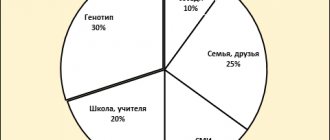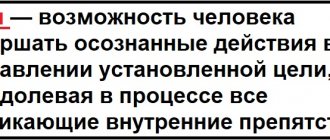What is reflection and reflexivity
“Reflecto” translated from Latin means “return back.” The same term in French sounds like “reflexio” and means “thinking, reflection.”
Initially, the concept of reflection appeared in philosophy as a tool for observing the external world and a way of understanding human existence. Through the analysis of phenomena occurring in nature and society, a person gets to know himself, seeks ways for survival and self-improvement. Today, the process of reflection is studied and used in other fields, in sociology and psychology.
Reflection
- this is a person’s look inside himself, analysis of his thoughts and actions and their rethinking.
But this process is not thoughtless, but based on acquired knowledge and experience, examined through one’s own mistakes. In addition, in sociology it is the ability to evaluate other people and make comparisons between them and oneself.
Reflexivity is the ability to analyze oneself, identify the motives of one’s own actions, including:
- past actions and events;
- successful or unsuccessful performance results;
- emotional state;
- personality traits and character that change over time.
The degree of reflection is different for each person and depends on the level of knowledge, intelligence, and upbringing. Some people constantly think about their actions and their motives, while others don’t think about them at all. An important role in this is played by a person’s desire to realize his misconceptions and mistakes, the ability to self-criticize and the need to compare himself with the people around him.
Reflection in psychology
A sign of a mature person is the ability to accept responsibility for her actions and the life she has. If a person constantly blames others and circumstances for what happens to him, he is considered weak. Changing your worldview can be difficult.
Reflection in psychology is used precisely for such purposes. As a separate, independent topic in psychology, reflection was highlighted by A. Busemann. This scientist suggested that this process is nothing more than the transfer of circumstances of the external world to oneself.
In Russian science, the problems of reflection were studied by such scientists as L.S. Vygotsky, S.L. Rubinstein, B.V. Zeigarnik. In their opinion, the basis of the concept is thinking, leading to self-understanding, the ability to find the motivation for one’s actions, and answers to questions about personal characteristics. Scientists first defined reflection as an opportunity to “learn the truth about oneself.”
Today, reflection is one of the main directions in psychology used to expand the client’s consciousness. For example, if a person is stressed due to negative daily thoughts, but does not understand this, then he will not be able to get rid of his bad mood. In this case, it is possible to stop suffering only by understanding the underlying cause of the decadent mood, and by determining steps to eliminate it.
With a conscious decision, you can stop the flow of unnecessary thought forms and accept yourself in the “here and now” state. The specialist encourages you to look at yourself “from the outside,” as if at the hero of a series on a TV screen. The goal of a good psychologist is to teach independent introspection and obtain answers to nagging questions. Within psychology, reflection and introspection are identical concepts.
When analyzing a certain situation or action, it is necessary to realize and work through the following points:
- A person’s sense of self at the current moment in time. What he experiences: anger, fear, shame, guilt, resentment, etc.
- A weak point in self-awareness that has been damaged by events that have occurred. For example, inflated expectations regarding the behavior of a spouse or other family members, which led to resentment.
- The ability to use the situation, as well as the difficulties that arise, to your advantage.
Reflection promotes understanding of how a person is perceived from the outside, and not just for self-analysis. The result of reflectivity is self-analysis, the formation of desired personal characteristics, and an understanding of the connection between actions and results.
Psychological reflection functions in the following directions:
- Consciousness control, which includes awareness of one’s own thoughts and actions. Formation of logical thinking.
- Understanding your strengths and weaknesses is self-criticism. The ability to recognize the relationship between current events, successes, failures and actions taken.
- Finding the keys to solving complex problems and tasks. The ability to plan your steps to achieve goals.
- Getting rid of destructive, destructive attitudes and thought forms.
- Finding opportunities to make thoughtful, correct, useful decisions.
- Accumulation and identification of latent abilities, talents and resources.
There is an opinion in psychology that reflection is not always good. In practice, there are cases when soul-searching and excessive thinking led to negative consequences (“woe from mind”, “many knowledge, many sorrows”). For this reason, it is important to learn to reflect competently, preferably accompanied by an experienced specialist.
Reflection as a quality of thinking
Professional reflection is usually understood as the relationship between the subject of an activity, himself, and the capabilities of his “I” with what the upcoming activity requires. In the study of reflection, there is a great diversity and multidimensionality of research areas, determined by generally accepted ideas in the domestic reflexive psychology of thinking and creativity about the mechanisms, levels, forms and typology of reflection. In acmeology, reflection is studied in the context of the reflective culture of the individual. The development of reflective culture as an integral quality of a professional’s personality lies in the cultivation of such dynamic components as reflective readiness, reflective competence, reflective-creative potential, and reflective ability. Reflexive abilities represent the relationship between self-esteem, self-control, self-regulation and self-correction. Reflection (reflexivity) is usually considered among the central professionally important qualities (PIQ) of an individual.
Much attention in the study of reflection is associated with professional activity. Professional reflection (reflexivity) is considered as a determinant of the success of a person’s activity; it contributes to the organization of his creative thinking, the growth of professional skills, and the mastery of new specialties. This allows us to consider reflection as a mechanism of personal and professional self-development, creative self-realization of a person as a professional.
For the first time, the general concept of professional reflection was introduced by B.Z. Vulfov, according to which, professional reflection is the correlation of oneself, the capabilities of one’s “I” with what the chosen (elected) profession requires.
So, for example, O.N. Homeland considers reflexivity to be one of the most essential personal protective skills of a person as a subject of professional activity. She draws attention to the fact that the overall assessment of the success of professional activity should include both an external criterion (assessments given by other people) and an internal one (one’s own assessment of the success of one’s activities). According to O.N. Homeland, a person with a high level of reflection is able to more adequately evaluate and organize his work and, as a result, achieve success.
In the study by A.V. Karpov studied and analyzed the nature of the relationship between an individual measure of the severity of reflexivity and some parameters of professional activity of a managerial and executive type. It was found that there is a complex relationship between the level of reflexivity (intellectual, personal, communicative and cooperative) and the effectiveness of management activities among senior managers, which is described by a “U-shaped” curve. This connection indicates that the greatest effectiveness of management activities is manifested at an average level of the measure of reflexivity. With low and very high reflexivity, a decrease in the effectiveness of management activities may occur. A similar relationship was considered in professional activities of a pronounced executive nature (among middle managers). It was found that there is a complex relationship between reflexivity and performance effectiveness, described by an “S-shaped” curve. Its meaning lies in the existence of a certain optimal interval (measure of severity) of reflexivity, at which the values of the “function” (the effectiveness of executive activity among middle managers) change most intensively. And, conversely, at minimum values of the measure of the severity of reflexivity, the effectiveness of performing activity does not yet increase, and at maximum values, it no longer increases. Consequently, there is a certain interval of change in the level of reflexivity, at which senior and middle managers are most sensitive to the perception and implementation of management influences.
In an experimental study by A.V. Karpov also found that the level of reflexivity influences not only the effective, but also the procedural, in particular, stylistic features of managerial and performing professional activities.
Currently, ideas about the importance of reflection in a person’s professional activity have expanded significantly. In the research of scientists involved in the development of acmeological problems of a person’s professional development, reflection is usually considered in the context of the general psychological culture of a professional.
For example, in a study by N.T. Selezneva, the psychological culture of educational system leaders is considered as a free creative type of activity that allows one to overcome subject-object relations, the authoritarian nature of goal setting and evaluation of activities, contributing to the creation of an atmosphere of mutual understanding, partnership, responsibility, initiative, and a system of collegial subject-subject relations. The psychological culture of a leader is represented by N.T. Selezneva as a set of comprehensive, accurate knowledge, skills, ideas, professional experience, personality traits corresponding to the powers and rights that are granted to him, self-awareness, humanistic principles of management. In order to study the psychological culture of a leader, it is necessary to consider such components as:
- structure of values, motives, attitudes and personal meanings;
- requirements for personality and joint activities; positions and relationships arising in the process of interaction;
- professional self-awareness and personal experience; features of the emotional-volitional sphere;
- mental independence and intellectual abilities, including reflective thinking.
According to S.Yu. Stepanov, who researched the problems of psychology of reflexive thinking and creativity, reflexive personality culture is characterized by:
- a person’s readiness and ability to creatively comprehend and overcome problem and conflict situations;
- skills to acquire new meanings and values;
- skills to adapt to unusual interpersonal systems of relationships;
- skills to pose and solve extraordinary practical problems.
The level of development of a reflective culture is manifested in the depth of rethinking one’s own experience, the degree of readiness to plan one’s activities. The main indicator of a person’s reflective culture is his ability to work in conditions of uncertainty. The development of reflective culture as an integral quality consists in cultivating such dynamic components as reflective readiness, reflective competence, reflective-creative potential, and reflective ability147.
The results of experimental studies have updated a number of problems associated with the study of applied aspects of reflection. Currently, methods for measuring reflexivity are being developed, an active search and development are being carried out for effective technologies for managing the development of reflection and reflective abilities in representatives of various professions (including teachers), starting from the first stages of vocational education and the professional development of a person as a subject of activity.
Reflexive readiness is expressed in the degree of generalization and specification of the mechanisms of self-knowledge, self-development and self-realization of the individual. An indicator of reflexive readiness is the activity of the individual in various conditions and situations to transform them. The main components of reflexive readiness are emotional, intellectual, motivational and behavioral components.
Reflective competence is defined as a personality quality that allows for the most effective implementation of reflexive processes, ensures development and self-development processes, and promotes a creative approach to activity.
Reflective and creative potential is expressed in the individual’s ability to solve problems in an extraordinary way. This ability manifests the highest form of creativity. Creative abilities ensure personal self-development, growth of professional skills, retraining and mastery of new specialties. The manifestation, implementation and development of creative abilities are closely related to reflexive abilities.
Reflective abilities provide conditions for the self-development of the individual, his self-correction and creative self-realization, contribute to the growth of professional skills and the mastery of new specialties. They generally influence the development of the individual and his relationship with the world. The development of a person’s reflexive abilities presupposes the formation of adequate self-esteem, a high level of self-control, and methods of self-regulation.
One of the main tasks in improving any professional is to learn to reflect, to intensively develop one’s own life and activities, to be able to see mistakes and look for ways to overcome them. According to B.Z. Wulfov, reflection is a special case of individual self-government. This understanding of reflection allows us to consider it as a mechanism of personal and professional self-development.
Concept of self-reflection
Self-reflection is often identified with reflection. This is partly true. The difference between the concepts is that the prefix “self” indicates a reflection of oneself, and not just the external world, events and other people.
Self-reflective people constantly listen to their own feelings and emotions and try to analyze them. Such exercises are very useful for understanding your own self, personal desires and needs. How often do we focus on the expectations of other people, looking for an assessment of our actions from the outside. As a result, one’s own dreams and internal needs remain unfulfilled.
Young people enter training in prestigious professions, and their souls are drawn to creative delights. As a result, the profession does not bring satisfaction, but the parents are happy! A person lives an uninteresting life, suppressing existing talents.
There is another side. In hypertrophied cases, a person constantly listens to emotions. He becomes fixated on personal experiences and becomes neurotic, not seeing the outside world, which is beautiful. A person stops enjoying life, constantly analyzing his own condition.
In this case, it is important to get out of yourself in time, take a deep breath, feel material things: table, floor, wall, hands, feet, sounds and smells.
Many people are wary of their own body signals. Often, excessive reflection leads to neurotic diseases, for example, hypochondria (a pathological condition in which we find ourselves with all possible and impossible diseases).
Cases have been recorded when women find all the signs of pregnancy, and only the results of repeated laboratory examinations (for example, ultrasound) can dissuade them from this. Of course, if you suspect a disease, you must undergo a medical examination. But when a person realizes that his fears are far-fetched, he should move away from focusing on personal feelings and ignore them.
Reflective thinking as a factor in the education and self-development of schoolchildren
Reflective Thinking
as a factor in the education and self-development of schoolchildren
In the behavior of a schoolchild, much depends on his conscious self-regulation, motives, and self-awareness developed in the process of education. This largely determines his or her meaningful acceptance or non-acceptance of social norms. In this sense, any person is an educator of himself. Therefore, there is an urgent need to include technologies in the educational process that ensure its effectiveness through the inclusion of mechanisms of individualized education. Individualized education involves the development or correction of individual consciousness through self-regulation mechanisms. One of these technologies is the technology of individualized reflexive self-education, which is built on the basis of the developments of the scientific methodological school headed by
O.S. Anisimov, P.G. Shchedrovitsky. This technology timidly enters into the practice of Russian educational institutions, only because its active use in the traditional system is difficult due to the process being built on the mechanisms of external motivation, while reflective thinking is one of the components of internally motivated activity. The transition to progressive ways of educating students makes this technology in urgent demand. The technology of individualized reflective self-education is based on the idea of pedagogical interaction with the goal of a deeper relationship between schoolchildren and themselves and the environment. The main task of using reflective technology is to provide assistance to the student, support in his self-education and self-development. The technology is designed to stimulate internal factors - efforts for self-development, which exist in every person, but can be either dormant or in an active working state. The technology of individualized reflective self-education can be used as an independent personal development program, or in combination with other technologies as an integral part. For example, with local technologies such as: technology of pedagogical interaction, technology of creating a situation of success, technology of presenting pedagogical demands, technology of conflict resolution. A situational classroom is proposed as the main form of technology for individualized reflective self-education (you can rely on N.P. Kapustin’s methodology for conducting situational classrooms). To apply the technology of reflexive self-education, it is important that the pupil’s reflective thinking is well-formed, allowing him to pass through his individual perception of one or another pedagogical situation in order to create conditions for activating the process of awareness, promoting internal reinforcement of moral-goal relationships and condemnation of negative ones, which stimulates the process of self-education and self-development of the individual . The life of any person as a whole consists of situations, that is, of such events, phenomena, facts in which the character, habits, and culture of human behavior are manifested. Such peds. situations are most easily determined in the process of joint creative activity of the teacher and students. At the same time, the problems that manifest themselves in these situations can be common to all students (inability to listen to each other, kindly evaluate the success of friends), specific to any group (inability to communicate, lack of internal discipline) and purely individual (use of profanity ). The tasks to be solved determine the scale of application of the technology of individualized reflexive self-education in each specific case.
Let us dwell on the definition of reflection. Reflection is a critical reflection on one’s own mental and practical actions in a situation “after the event” in order to learn from one’s own life experience. Reflection on the pedagogical situation is always carried out when psychological difficulties arise in the successful implementation of activities. I am close to the point of view of N.E. Shchurkova on the development of reflection: “This is assistance in the formation of a personality capable of being aware of the free choice that it makes, correlating the desired and the real, the expected and the accomplished, actions and consequences, one’s own interests and the interests of others.” Reflexive actions play a special role in the development of self-awareness when communicating and interacting with other people in the process of providing feedback. This allows the student to adjust his activities and communication, and arbitrarily control his behavior. Piaget interprets reflexive thinking as a process carried out on the basis of the subject’s knowledge of the logical laws of connection between an object and the action directed at it and analysis of the need for such a connection. In my research, reflective analysis is highlighted as a special psychological reality, the essence of which lies in the student’s acquired experience of personal “awareness - comprehension - rethinking” of experience, assessment, attitude towards what is associated with the activities of students in situational classroom hours. The technology for conducting a situational class hour includes the following components:
— awareness by each participant of the purpose of the upcoming discussion and its acceptance,
— availability of necessary information on the problem under discussion for the purpose of further analysis,
- internal fixation of “I-position” on the issue under discussion,
— determination of the reason for the “I-position” in the designated situation,
- internal comparison of “I-position” and socially significant norm,
- reflection of the entire event,
- free choice of norms of behavior, as a result of internal work on oneself,
— providing pedagogical support to those students who have shown a willingness to bring their “I-position” into line with social norms,
— monitoring changes in schoolchildren’s attitudes to the process (phenomenon) under discussion.
Also, a reflexive analysis of the pedagogical situation can be carried out according to a more concise scheme:
— “Awareness” (What happened to us before the current situation arose?).
— “Comprehension” (What changes happened to us during the situation?).
— “Rethinking” (What new problems have arisen before us and ways to solve them?).
The main objective of my research is the development of reflective analysis, using the technology of individualized reflective self-education through situational classroom hours, reflective screensavers in lessons, and individualized pedagogical communication with students. The experimental group consisted of students in grades 10-11, where I was the class teacher.
Pedagogical concept “Man. Culture. Health”, adopted by the Municipal Educational Institution “Secondary School No. 5” of the city of Sayansk in 2005 within the framework of the meta-project “Development of the student’s personality in the educational space of a small town” involves the education of a physically, psychologically, morally healthy student’s personality in the educational system “School of Health”. In accordance with this, I have developed a Classroom Education Program, which is provided with diagnostic support, which also allows us to track the formation of reflective thinking, which is a leading factor in the education and self-development of students’ personality.
The social activity of students was monitored using the method of Stefanovskaya T.A.
Graph 1. Level of social activity of students.
The graph shows the positive dynamics of students’ social activity: a significant decrease in the number of children with a low level of social activity, an increase in the number of children with an average level of social activity and the relative stability of the group of children with a high level of social activity.
According to the school's psychological service, the psychological climate in the team is favorable. The level of school anxiety, determined by the Philips method, is normal.
Histogram 1. Level of optimism of students in grades 10-11a.
The histogram of students’ optimism level reflects a teenager’s sober view of the world around him.
Monitoring of components of grades 10-11 was carried out in accordance with new indicators corresponding to the graduate model.
Histogram 2. Component of moral health.
Histogram 3. Physical health component.
Histogram 4. Psychological health component.
Histograms 2, 3, 4 demonstrate the positive dynamics of knowledge and skills about the components of health of graduating class students.
New technologies of education transfer the problem of students onto their own shoulders, making them responsible for their choice, for their decision. The organization of this process has its own laws that cannot be neglected in that complex internal psychological work with those who have trusted you and expect psychological help and support from you.
The basic rules that a teacher needs to know, formulated by G.Yu. Ksenzova, make it possible to organize the educational process from the position of preserving the honor and dignity of the student:
- A student cannot be accused of insincerity or dishonesty, even if he is clearly deceiving others at the moment. The fact is that in a critical situation, the instinct of self-preservation, characteristic of both adults and children, operates, then the work of thought and feeling begins, this will be the moment of victory of professional pedagogy, the moment of the child’s victory over himself.
- You should not evaluate events (good, bad, more appropriate), it is important to include schoolchildren in self-assessment based on comparison of their actions and behavior with the norms of life.
- The student evaluates himself at the moment based on his level of maturity, self-defense reflex and attitude. Here, too, patience is needed until he realizes what life standards require of him.
- One should not criticize the student’s choice of position; it may correspond to a positive norm, or it may be different; Few people have a negative attitude towards living standards.
- It is important that students themselves, by comparing opposing points of view, come to the right choice. Therefore, in situational classroom hours, it is better to combine them into microgroups in such a way that they include students with positive and negative attitudes towards certain social phenomena.
- The discussion of the situation or problem must be specific. To do this, in a conversation, instead of the words “we”, “everyone”, it should sound “I think so”. You need to talk about your specific behavior and the reasons that prompted it.
The result of the application of the technology of individualized reflexive self-education is the humanistic nature of the relationship, which makes it possible to successfully provide a mechanism for self-education and self-development of the child’s personality.
Forms and types of reflection
We described reflection as a complex process directed both within oneself and into the external world, leading to benefit for the individual, or, on the contrary, to its destruction. Let's consider what forms and types of introspection exist in psychology.
From the point of view of the impact on the future state of a person:
- Correct constructive self-analysis, which allows you to understand yourself, draw logical conclusions and not step on familiar mistakes again.
- Harmful destructive self-analysis, leading to neurotic disorders and deep fixation on problems, often imaginary. In such situations, feelings of guilt, helplessness and hopelessness are cultivated. A person needs the help of a specialist.
Taking into account time periods, reflection occurs:
- Event-based or situational
. The individual analyzes a problem that takes place in the present time, “here and now.” - Retrospection
, looking to the past. A person evaluates past events and his actions, draws conclusions about their correctness and timeliness. - Perspective
, facing future events. The individual plans further actions and events based on self-analysis.
Based on the object of study, the process can be divided into the following forms:
- Self-reflection
, turning to one’s own inner world, personal experiences and emotions. - Communicative
. In this form, reflection is devoted to other people, interaction with friends, relatives, and colleagues. A person tries to analyze relationships and interactions. - Sanogenic
is a type of self-analysis in which a substantive study of strong emotions is carried out, a search for means to minimize or eliminate unnecessary suffering and experiences. - Intelligent
. The individual’s attention is focused on the application of knowledge, skills, and the possibilities of their use in the material world.
A combination of forms of reflection under given conditions gives the best results; it is always necessary to combine methods of analysis for a specific situation.
Reflection: what is it in psychology. Definition and forms
There are also three forms of reflection, which depend on their focus:
- situational - analysis of what is happening in the present time (right now I am sitting on the couch and writing this text);
- retrospective – assessment of past experience. This form is useful in that we can draw useful conclusions for ourselves based on inferences about past events (yesterday I was writing a text on the same couch and the TV was on, disturbing me. That’s why today I’m working in silence);
- perspective – thinking, planning for the future. Preparing myself for future events (perhaps tomorrow I’ll give myself a day off and just lie on this couch).
What does it mean to reflect?
Reflect
- is to think, to think logically, to analyze actions and actions, to know oneself.
Is it worth understanding your personality? Of course yes. If a person has not understood himself, he is led by others and lives someone else’s life. Low self-esteem, complexes, and feelings of guilt sit deep inside and interfere with further development. They need to be found and neutralized.
By reflecting, we learn:
- Think rationally.
- Stop mental “garbage”.
A low level of self-analysis is the path to making the same mistakes and blunders throughout your life. At the everyday level, the concept of a reflective person is often associated with such definitions as: “to be nervous”, “to worry”, “to worry too much”. Therefore, in any action, moderation and reasonableness are important.
It is necessary to approach your inner world soberly and calmly, without allowing emotions to overwhelm the arguments of reason. A person who knows how to reflect is his own psychoanalyst; not everyone is capable of this.
In order to “self-examine” for the benefit of your business, you need to avoid the following mistakes:
- You should think about the motives for your actions, not the actions themselves
. For example, a husband who cheated on his wife may realize his betrayal and vow not to do it again. But if a man does not understand what pushed him to cheat, no force will stop him from repeating the mistake, since the motives for the need to go “to the left” will remain undeveloped. - "Saw sawdust"
, as D. Carnegie said. This means constantly grinding past sins and failures in your head, coming up with possible other consequences of what has already happened. What was is no longer there, think about the current moment, make plans for the future.
- Cultivate a sense of guilt
. Yes, we made a mistake, but we got our lesson for it. There is no point in berating yourself for something that cannot be fixed. Everything is not without sin.
- Responsible for the whole world
. Processes in the world occur against our will. We should not take responsibility for something we cannot influence.
If you follow the rules outlined, then reflection is not only possible, but also useful.
How to develop reflection
The best way to learn a skill is to start practicing it. To develop reflection, you need to start practicing it.
How to do it?
- Try to understand what feelings you are experiencing at the current moment. The habit of being attentive to emerging joy, anger, melancholy and connecting them with ongoing events or communications with certain people.
- Monitor stories in which you react too harshly, painfully. If certain events hit you particularly hard, you need to understand what the trigger is.
- If you notice that in the process of thinking about something you experienced melancholy or painful emotions, then it is better to stop soul-searching and return to the roots of the problem a little later. Highly sensitive people cannot do without the help of a specialist.
- Give up total control of reality. Reflection is not a reason to put the material world into pieces. Allow life to flow outside of your participation.
- In the evening, you can “scroll” your day in your head, all its pros and cons, and form plans for tomorrow.
- To develop reflection, make it a rule to think systematically about any phenomenon or object that interests you.
After gaining reflection skills, you can ask yourself a few questions and give honest answers to them:
- Think about whether there is something in the past that would be worth returning to and trying to start over. This could be family, work, hobbies, friends, etc. Sometimes a return to the past means the beginning of a new stage.
- Clearly establish for yourself what brings pleasure and makes you happy. This will be the strategic goal to which you should devote your future life.
- If you are not happy with the point you are in now, determine the actions you need to take to get out of it. Do not slip into self-flagellation or attribute all problems to external circumstances.
- Truthfully answer the question of what you are doing wrong. You should not wring your hands with the question: “Why do I need this?” Take responsibility for failures personally. Where was the mistake, the flaw? The truth can be unpleasant, but without it it’s difficult to fix anything.
- If you fail at a question, analyze whether everything possible has been done or whether you can try something else.
- Analyze actions from the point of view of achieving the goal. This does not mean that you cannot be spontaneous and that you need to think through every step. However, when time is short, prioritization becomes necessary.
There is an opinion that the purpose of life is life itself, getting pleasure from it and those things that correspond to our internal needs. Reflect wisely, achieve what you want and be happy!
9.7. Psychotechnics of reflective thinking
The concept of reflection. Reflection (translated from Latin - turning back, towards oneself) - turning consciousness towards oneself, a thought about a thought. The reflexive phenomenon is very polysemantic; in the most general form, three main meanings of the concept are distinguished. Firstly, this is philosophical and methodological reflection - awareness, understanding by science of itself, its subject and method. The concept of reflection was developed by Descartes, Locke, Kant and other classics of philosophy. Their ideas formed the basis for understanding the reflexive phenomenon in psychology. The surge of interest in reflection in modern Russian science is associated with the name of G.P. Shchedrovitsky and the activities, starting from the mid-50s, of the Moscow Methodological Circle, which had a noticeable influence on relevant developments in psychology, including legal psychology.
Secondly, this is individual psychological reflection - self-knowledge, human self-awareness. It is well known that the most difficult thing is to know yourself. Traditionally, this is one of the current topics in psychology and one of the most important areas of its practical application, including in the legal field. High professional responsibility of a lawyer presupposes
It means increased self-control, thoughtful decision-making, understanding of one’s personal capabilities, clear self-organization, and therefore the ability to reflect.
Thirdly, this is socio-psychological reflection - putting oneself in the place of another person and thinking for another person. It is in this sense that the concept of reflection is used primarily in legal psychology. The starting point for the subsequent socio-psychological studies of reflection was the well-known work of methodologist V.A. Lefebvre,1 who first introduced and developed the concept of reflection in this meaning. The reflective model has proven to be very productive in; studying conflict, cooperation, communication.
The concept of reflection in legal psychology, starting from the first works of Lefebvre, was introduced by A.R. Ratinov.2 He authored special work on reflection in legal psychology.3 The complexity of the reflexive phenomenon, unfortunately, limited its further research in legal psychology. In subsequent works (A.V. Dulov, 1975; V.E. Konovalova, 1978; N.L. Granat, A.R. Ratinov, 1978, etc.), reflection is used mainly to reveal the psychological nature of the investigator’s thinking, interrogation, search and other investigative actions. At the same time, the conflict interaction between the investigator and the person under investigation is considered within the framework of cognitive activity, reflexive play and reflexive management. In recent years, reflection has been actively used in practical legal psychology to interpret professional communication.4
Reflective thinking in the activities of a lawyer. Reflective thinking is a mental professional-psychological action of a lawyer, ensuring the solution of the most intellectually complex professional tasks. The specificity of the reflexive mode of thinking differs markedly from ordinary logical reasoning and is most characteristically represented in the formula “I think that he thinks that I think.” A schematic, now classic, example of this kind, which clearly reveals the essence of reflexive thinking, is given by A.R. Ratinov:5
The investigator is searching for a criminal who fled the scene of the murder. Most likely, he could have left in two ways: one of them - “A” - is convenient for movement, but more crowded and dangerous, the other - “B” - is more difficult, but is not associated with such risk. The persecuted person reasons like this: “Let “B” be better than “A”, so I choose path “B”. The investigator, assessing the situation, must reproduce the criminal’s reasoning and draw the appropriate conclusion from here: “The killer knows that path “B” is better for him than path “A”, and therefore chooses “B”, which means I must pursue him along this path paths." However, if the criminal is not inferior to the investigator in reflection, he can reason like this: “The investigator, believing that I, knowing that path “B” is better than “A,” will move along the second path, will pursue me along path “B,” therefore I choose path "A". The investigator, surpassing the criminal in the rank of reflection, must mentally recreate the course of his reasoning and their result, after which, having made the appropriate decision, capture the wanted person, unless he
1 Lefebvre V.A. Conflicting structures. 2nd ed. - M., 1973.
2 Ratinov A.R. Forensic psychology for investigators. - M., 1967.
3 Ratinov A.R. The theory of reflexive games as applied to investigative practice. // Legal cybernetics. - M., 1970. P. 185-198.
4 Noskov B.A. Psychotechnics of communication. — Nizhny Novgorod, 1997.
5 Ratinov A.R. Decree. Op. — P. 190.
outplayed the investigator in this competition of wits, imitating the reasoning and decisions of his opponent more accurately and at a higher level. More complex calculations are also based on this principle, although in real human conflicts the imitation of a partner’s reasoning rarely exceeds the second or third stage.
Reflective thinking is not only used in solving and investigating crimes. In a broader sense, the use of reflection makes it possible, as noted by A.V. Dulov:1
• constructing a mental model of the behavior of various participants during a past cognizable event;
• planning your own cognitive activity;
• predicting the behavior of participants in the process during the proposed procedural actions;
• developing a system of influencing individual participants who are sources of obtaining the necessary information;
• development of a system of influence for the purpose of re-education of persons who have committed offenses.
The practical use of reflective thinking in the activities of a lawyer, taking into account the certain complexity of this professional psychological action, presupposes mastery of technology and appropriate techniques.
Reflective thinking technique. It includes three main techniques: entering a reflexive position, reflective display of the situation and reflexive justification of activity.
Technique for entering a reflexive position. The essence of the technique is to change the point of view on the situation in which a difficulty has arisen, from internal to external, to go beyond the limits of the situation, to a position that allows you to understand the situation and find a way to resolve it. Reflection is a very “subtle” organization of thinking, and in order to master the technique of reflexive exit, it is important for a lawyer to understand three points: why and where to “exit”, where to “exit” and how to record the “exit”.
Awareness of difficulty in activity and recording the situation in which it arose. If everything flows smoothly, then there is no need for reflection. But as soon as a difficulty arises in the activity, it is recognized and the lawyer realizes that “something is wrong.” Awareness of the difficulty is the initial moment of reflection. At the same time, it is important to define the boundaries of the situation in which the difficulty arose. For example: “I don’t understand what is unclear to the interlocutor on this issue” or “What way to proceed next.” A reflexive exit is necessary in order to find a way to overcome difficulties in activity, and for this you need to mentally go beyond the boundaries of the situation that has arisen.
Choosing a reflective position. A reflective position is an angle, a point of view on the situation under consideration. For a lawyer, this may be the position of a specific interaction partner (interlocutor, client, victim, criminal, etc.), another professional and official position of a fellow lawyer (judge, prosecutor, lawyer, investigator, operative worker, etc.) and even any other position different from the original one. The choice of a particular position is determined by its potential usefulness in relation to a given situation. At the same time, such a position can be specified: “look at the situation through the eyes of a disinterested witness,” “what would a more experienced professional colleague do here,” etc. Each position sets its own way of “seeing” the situation and relating to it. The potential range of legal positions and roles is vast. It is useful to expand their repertoire by mastering them and making them familiar to your own thinking.
1 Dulov A.V. Forensic psychology. - Minsk, 1975. - P. 67.
Self-determination and reflective attunement. To capture a reflexive exit, it is important for a lawyer to self-determine in the chosen position. For example, “from this position, when assessing this situation, you need to take into account the following.” Self-determining the situation, the lawyer masters the chosen position, identifies two or three most important points that determine this angle of view on the situation. At the same time, it is important to reflexively tune in to a rational understanding of the situation from a new position, controlling the detuning from the emotions that accompanied the initial experience of the original difficulty.
Possession of a wide repertoire of professional legal positions and the ability to reflexively enter into these positions make it possible to develop a lawyer’s “positional” thinking, the ability to think legally from different points of view, which largely ensures the effectiveness of his actions.
Technique of reflective reflection of the situation. It happens that a successfully found position, point of view on the situation, as it were, automatically forms the corresponding image, idea, “vision” of the reasons for the difficulty that has arisen. However, more often than not, a reflexive exit in itself is not enough and it is also necessary to reflexively organize the display of the situation in the lawyer’s mind. ; One of the ways here is the lawyer’s reflexive reasoning when understanding the situation and the reasons for the difficulty, i.e. reasoning with a clear fixation of the position from which they are made. For this, appropriate speech words are used! formulas constructed, in particular, according to the scheme of a thought experiment (“If, then...”): “If I were in the place of the criminal, then I would...”. In this case, it is very important to take into account the “nesting” rule, when information extracted from a situation is strictly associated with a specific position (for example, according to the principle of nesting dolls nested one inside another).
An illustration here can be the well-known riddle about the caps worn by wise men. The simplest version is this: there are three caps - two white and one red. Two people take part in the game. The presenter explains to them that he has three caps and shows them. He further says: “I will now put a white or a red cap on each of you so that you will not know which one. But try to answer which cap you are wearing.” Both wear white caps. One reasoned: “He’s wearing white, so I can be wearing white or red.” The other one also sees white and thinks in exactly the same way. At this moment in time, neither one nor the other can say anything about their cap and are silent. Then any of them can reason like this: “If the other is silent, it means he doesn’t see the red cap on me. And if so, then he sees white on me.” The reasoning here contains the first level of depth of reflection.1 The lawyer, of course, is not talking about caps, but the principle is the same.
Social psychology of personality. - L., 1974. - P. 143-144.
Reflective reasoning when comprehending a situation is usually difficult to keep in mind. Hence the need for schematization, constructing a diagram of the situation that organizes its main elements from a certain position. We will call a schema a structurally organized unity of elements or a structure of elements if the elements belonged to another integrity from which they were extracted for schema formation.1 Without schematization, it is usually difficult to understand a confusing legal situation. It is generally accepted that a diagram is something simplified and primitive. This is wrong. The diagram really simplifies, but at the same time generalizes. The use of several diagrams, prepared from different positions, allows us to better understand the most complex legal situation and understand the causes of the difficulties that have arisen. For this, it is important to objectify the schemes and their elaboration. This is usually done graphically on a board or paper. In the field of methodology (O.A. Anisimov), a special language of schematized images has been developed for these purposes.
So, the essence of the technique of reflective reflection of the situation is to organize the understanding of the difficulties that have arisen through reflective reasoning and schematization. “Scheme” thinking is a powerful intellectual resource of a lawyer.
Technique of reflective justification of activity. Reflection provides not only an objectified idea of the situation and the causes of difficulties, but also the basis for activities that correct the situation. The essence of the technique is precisely in the transformation of the reflexive picture of the situation into the basis for such activity. This is usually associated with reflexive control. Reflexive control by V.A. Lefebvre calls the process of transferring the grounds for making a decision by one of the characters to another.2 This control is carried out not as a result of directly imposing one’s will on the other, but by transferring to him “grounds”, from which he, as it were, deductively deduces the decision predetermined by such a ground.
In order for the picture of the situation to be accepted as a basis for making a decision, it must become acceptable, “normal” for the decision maker. It is necessary to develop an idea of the norms to which activities must obey in order to achieve success; appropriate rationing and renormalization of activities is necessary to resolve the situation and overcome difficulties. These are primarily legal and ethical standards. A norm is a prescription for activity; it consists of ideas about future activity and the prescriptive status of these ideas. O.S. Anisimov identifies the following types of norms: goal, plan, technology, program, project, method, technique, approach, principle.3 A broad interpretation of norms in modern methodology opens up additional opportunities for reflexive justification of activity.
Reflexive justification of activity is also associated with the development of a scenario for gaming behavior. After all, playing a role is the exercise of ordinary reflexive management.4 Flexible use of different norms and a variety of scenarios increases the effectiveness of reflexive management.
Mastery of reflexive thinking techniques is an indicator of a high level of development of professional thinking and activity of a lawyer.
1 Anisimov O.S. Fundamentals of methodological thinking. - M., 1989. - P. 174.
2 Lefebvre V.A. Decree. Op. — P. 43.
3 Anisimov O.S. Decree. Op. — P. 215.
4 Lefevre V.A.
Decree. Op. — P. 92. © 2010-2013 adhdportal.com. All rights reserved. Materials from this site may only be used with reference to this site.











